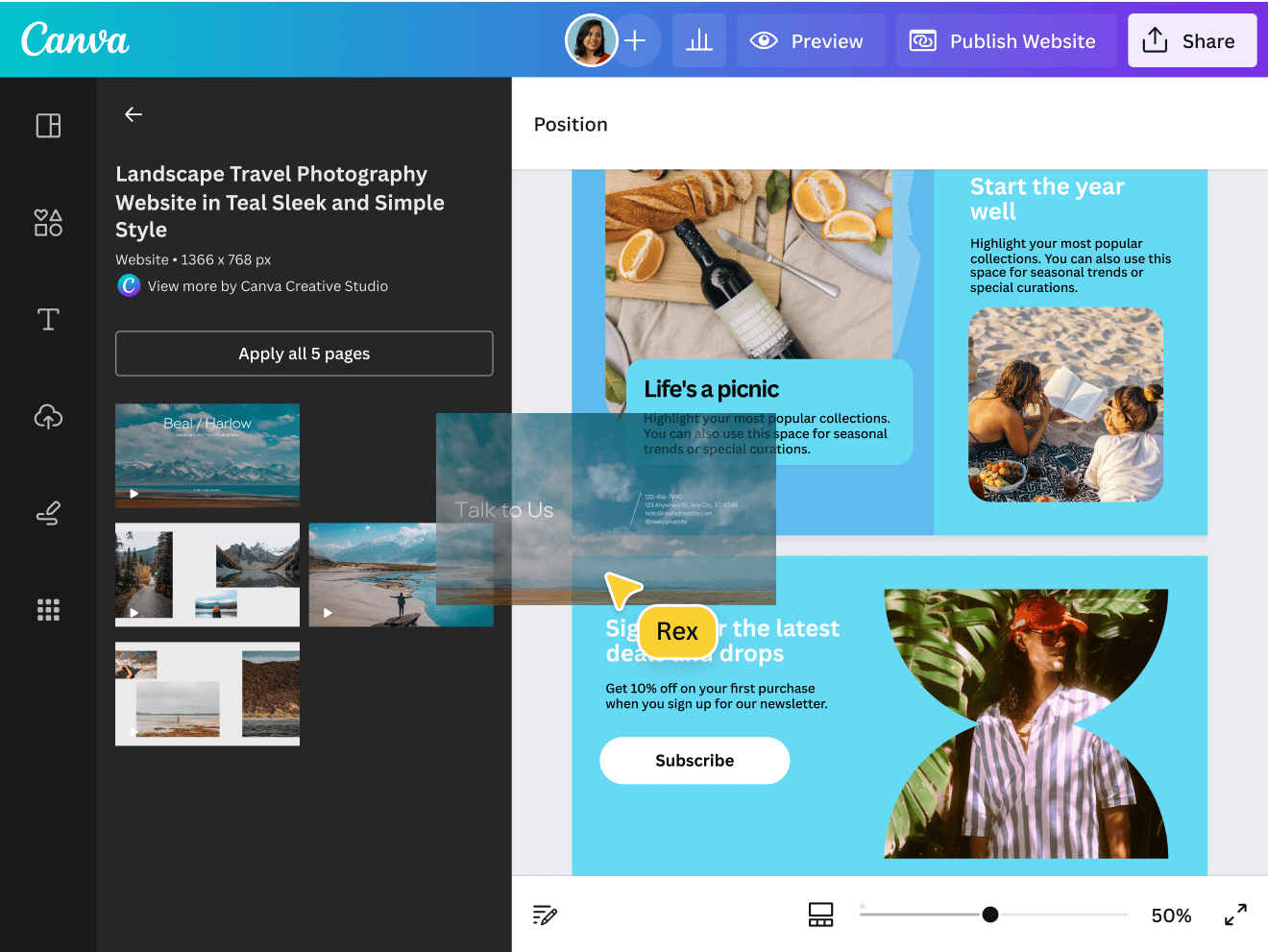Web Design London Ontario for Retail Website and Companies
Web Design London Ontario for Retail Website and Companies
Blog Article
Just How to Effectively Combine Appearances and Performance in Internet Style
When making a website, you need to strike an equilibrium in between aesthetics and performance. It's not practically looking great; your layout ought to likewise serve a function and guide individuals efficiently. By concentrating on simpleness and intuitive navigating, you can create an interesting experience. But what elements genuinely improve functionality while keeping visual charm? Allow's discover the key concepts that can result in a harmonious mix of elegance and feature.
Understanding the Importance of Looks and Capability
When you create a website, comprehending the balance between looks and functionality is necessary for developing a reliable user experience. A visually appealing site grabs attention, yet it's the functionality that keeps customers involved. If your website looks terrific but is difficult to browse, site visitors will rapidly weary and leave.Consider your target audience and what attracts them in. You desire to create a design that shows your brand name while guaranteeing simplicity of usage. Streamlined formats, intuitive navigating, and clear contact us to activity can improve both appearances and performance.

Concepts of Reliable Website Design
To produce a reliable website design, you need to stick to a number of crucial principles that boost both individual experience and aesthetic allure. Prioritize simpleness; a clean layout aids customers browse conveniently. Make use of a constant color design and typography to keep comprehensibility throughout your site. This fosters knowledge and trust.Next, assure your layout is responsive. Individuals gain access to web sites on numerous gadgets, so your layout should adjust flawlessly. Take note of aesthetic hierarchy; emphasize essential components with color, size, or positioning to lead users' focus.Finally, integrate sufficient white room. It stops clutter and makes material more absorbable. Bear in mind, effective web style equilibriums looks and functionality, so every style option should serve a function. By adhering to these concepts, you'll create a website that's not just aesthetically enticing but also easy to use, eventually keeping site visitors involved and urging them to return.
Prioritizing Individual Experience
When prioritizing customer experience, you'll wish to start by understanding what your customers absolutely need. Simplifying navigation style can make a substantial difference in how quickly they find what they're seeking. Likewise, improving aesthetic pecking order assists guide their attention to one of the most crucial elements on your site.
Recognizing User Needs
Comprehending individual needs is important for creating an appealing web experience that keeps visitors returning. To achieve this, you should determine the goals and preferences of your target market. Start by performing individual research, like surveys or meetings, to collect understandings on what users worth most. When communicating with similar web sites, pay focus to their pain points and difficulties. This information permits you to tailor your layout, guaranteeing capability straightens with individual expectations. In addition, consider producing customer identities that stand for various sections of your audience, aiding you envision their needs throughout the design process. When you focus on understanding individual requirements, you create a site that not just looks wonderful however additionally supplies a seamless, enjoyable experience that promotes loyalty.
Streamlining Navigation Style

Enhancing Visual Hierarchy
A solid aesthetic pecking order is important in guiding individuals through your site and guaranteeing they engage with vital web content. To attain this, utilize dimension, shade, and spacing tactically. Make crucial components like headings larger and bolder than body message, drawing focus promptly. Make use of contrasting shades to highlight phone call to activity, motivating clicks. Additionally, employ ample white space to separate sections, making material digestible and inviting.Consider the circulation of information; set up elements practically, leading individuals' eyes from one indicate the following. Usage visual cues, like lines or arrowheads, to route focus. By prioritizing aesthetic power structure, you boost user experience and raise the likelihood of conversions, guaranteeing your site is both cosmetically pleasing and functionally reliable.
Color Concept and Its Influence on Usability
While selecting the best colors for your site may appear like a minor information, it substantially affects use and user experience. Color impacts just how individuals regard information and can boost or prevent navigation. For instance, contrasting colors can aid important elements stand out, making it easier for site visitors to discover what they need.Additionally, consider the psychology of shades: blue usually motivates depend on, while red creates urgency. Understanding your target market can assist your shade options, assuring they resonate well.Moreover, regular color design help build brand identity, making your site more memorable. Be mindful-- as well numerous shades can bewilder individuals. Stick to a minimal palette that matches your content and maintains clarity.Incorporating availability is also crucial; validate your shade combinations are pleasant for those with visual disabilities. By thoughtfully using shade theory, you'll improve use and produce a much more appealing user experience.
Typography: Harmonizing Design and Readability
Color choices established the stage for your web site, however typography plays a just as important duty in enhancing user experience. You desire your text to communicate clearly while likewise reflecting your brand name's character. Start by picking font styles that are not only eye-catching but additionally legible. Sans-serif fonts often work well for electronic screens, as they're simpler to check out at numerous sizes.Maintain a hierarchy by utilizing different typeface dimensions and weights; this guides users with your content effortlessly. Take into consideration line spacing and letter spacing; as well limited can annoy visitors, while also loose can disrupt the circulation. Limitation your typeface choices to two or three to keep the layout cohesive.Finally, constantly examine your typography throughout different tools and browsers. What looks excellent on one display may not on an additional. Stabilizing design with readability warranties that your message reverberates, keeping your target market educated and engaged.
Responsive Layout: Making Looks Function on All Tools
To assure your website looks fantastic on any gadget, you'll require to accept receptive style concepts. This approach warranties your site adapts to numerous display dimensions, supplying an excellent customer experience. Begin by utilizing fluid grids and versatile photos that scale flawlessly. Rather than repaired measurements, select percentages and family member systems, allowing your layout to readjust dynamically.Next, implement media queries in your CSS. These allow you use various styles based upon gadget qualities, like screen size. In this manner, you can keep visual appeal while assuring functionality.Don' t forget about touch targets; make sure buttons and web links are very easy to tap on smaller displays. Focus on crucial content, so customers can conveniently navigate your site despite their tool. By concentrating on these elements, you'll develop an engaging, aesthetically appealing experience that fulfills the demands of all individuals, whether they're on a tablet, desktop computer, or smartphone .
Performing Use Testing for Constant Improvement
To improve your web layout, you need to establish clear usability goals that straighten with user requirements. By carrying out user tests, you can gather valuable feedback on how actual people engage with your website. Analyzing these outcomes will aid you make notified renovations and produce a much more reliable user experience.
Specifying Usability Goals
While aesthetic appeals can draw users in, defining use objectives is necessary for ensuring their experience stays gratifying and smooth. Start by recognizing what you want customers to achieve on your site (website design london Ontario). Consider their demands, habits, and tasks. Are they looking for details, purchasing, or registering for a newsletter? Develop clear standards to measure success, like task here completion rates or time on task. Focus on instinctive navigating, obtainable web content, and receptive style to boost usability. Frequently review these goals as individual assumptions evolve. By specifying usability objectives, you create a framework for examining and improving your website's efficiency. This focus on use not just enhances customer fulfillment yet additionally strengthens the general effectiveness of your layout
Carrying Out User Tests
Conducting customer examinations is essential for refining your site and ensuring it fulfills your target market's requirements. Begin by identifying your target customers and creating an examination plan that describes your goals. Use a mix of qualitative and quantitative approaches, such as studies, meetings, and task-based observations, to gather comprehensive comments. Welcome participants to navigate your site while you observe their interactions and keep in mind any problems they run into. Encourage open dialogue to record their ideas and feelings regarding the layout and capability. Keep sessions brief and concentrated, ensuring you cover key locations without frustrating customers. Make sure to document all searchings for, as this information will certainly be vital for making enlightened design decisions that improve both aesthetics and use.
Assessing Test Results
Just how can you successfully evaluate the results of your usability tests to drive continuous improvement? Beginning by categorizing comments right into usual styles. Try to find patterns in customer actions that highlight discomfort factors or locations for enhancement. Use quantitative information, like task conclusion prices and time on job, to determine use objectively. Don't forget to consider qualitative insights from user remarks; they commonly disclose underlying problems that numbers can't reveal. Prioritize one of the most impactful searchings for and create workable products for your layout group. Remember, it has to do with iterating-- execute adjustments, then test once again. This cycle of screening, analyzing, and refining assists you balance aesthetic appeals and functionality, ensuring your web site fulfills user needs properly while keeping visual charm.
Often Asked Questions
Exactly how Do I Select the Right Color Palette for My Internet site?
To choose the ideal shade palette for your internet site, consider your brand's individuality, target market, and emotional impact (website design london Ontario). Usage color psychology, produce consistency, and guarantee readability. Test combinations to see what resonates best with visitors
What Equipment Can Aid With Internet Style Aesthetic Appeals and Functionality?
You can utilize tools like Adobe XD, Figma, and Map out to improve your website design's aesthetics and performance. These systems supply intuitive user interfaces, cooperation attributes, and pre-made design templates to streamline your creative process and boost your designs.
Just How Can I Integrate Animations Without Jeopardizing Performance?
To include animations without compromising performance, prioritize refined results that boost user experience. Usage CSS computer animations for smoother communications, warranty quick lots times, and examination on various devices to keep efficiency while adding visual allure.
What Prevail Blunders to Prevent in Website Design Looks?
When developing, stay clear of chaotic layouts, poor color choices, and irregular typefaces. Do not neglect mobile responsiveness, as it can alienate customers. Verify your layout lines up with your brand, developing a smooth experience that engages visitors efficiently.
Exactly how Frequently Should I Update My Website's Layout for Optimum Appearances?
You need to update your web site's layout every 1-2 years to keep up with fads and preserve optimal aesthetic appeals. On a regular basis restoring visuals helps involve site visitors and guarantees your site stays appealing and easy to use. When you design a site, comprehending the equilibrium in between appearances and performance is vital for producing an effective individual experience. To create a reliable internet layout, you need to stick to a number of vital concepts that enhance both individual experience and aesthetic appeal. Individuals access sites on numerous devices, so your design needs to adapt effortlessly. When prioritizing user experience, you'll want to begin by comprehending what your users truly require. Beginning by conducting customer study, like studies or interviews, to gather insights on what individuals worth most.
Report this page